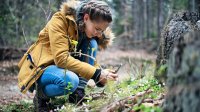Using Simple Outdoor Science Lessons to Inspire Students
Open-ended prompts can guide students to explore life science processes in the world around them.
Your content has been saved!
Go to My Saved Content.Providing meaningful pedagogical change for my students’ benefit in a way that is organic and impactful is my ultimate goal, and it has proven difficult to achieve.
When I recently reflected on my teaching, it showed far too much time spent on content-driven sprints instead of focused, process-oriented marathons. I could see that the science process had fallen away from my instruction. There had been no opportunities for students to “do science”—they had just been learning about science concepts. Students learning about life science and natural science behind a classroom desk every day seemed a bit backward. Hoping to rekindle curiosity about the outdoors and a desire to reconnect with students, instead of learning science only in traditional ways, we moved outside.
Participatory outdoor experiences and student choice proved foundational for me in helping students begin to like and appreciate science and learning again. I will share one example of that process.
Begin With Open-Ended Prompts to Initiate Observations
My sophomores and I spent time outside at the beginning of the school year, doing simple observational tasks. My outdoor lesson prompts were open-ended: “Write down some observations you can make.” Observations were the focus; moving beyond visual identifications was the goal. We made cursory observations first and then focused on sensory mapping, a practice where students find an isolated spot and chart, in real time, the changes they observe around them.
My students mapped a grassy area east of our building. After that, we discussed common themes that they chose to represent their surroundings. How many students noticed the plane flying overhead? How many recorded the dump truck driving by? With these questions, they became more attuned to their surroundings and thought about their environment in a new light.
Later that week, we went back outside, and they recorded biotic and abiotic factors using the skills learned earlier. Eyes widened—they were getting excited.
Inspire Wonder in the Details
Here are some of my initial observations of students getting outside:
- Laughing after inadvertently walking through a spiderweb
- Admiring a praying mantis mimicking wind movement
- Discovering a shoelace used for nesting material
- Furrowing brows while asking about bagworm cocoons
The classroom content was composed of small details of students’ learning. Experiences became our vocabulary. They were all fluent. This is the school I want.
My students still talk about those couple of days spent outside, discussing rudimentary science concepts. Genuine outdoor learning stirs wonder in us—wonder about the natural world, questions asked without thought, and excited anticipation when interacting up close with bugs and critters.
Encourage Discovery-Based Education
Teaching in a free-form style is difficult. Many students commented that making observations was difficult because of the lack of instruction. My students often want to know the task, and they work to complete it so they can be absolutely sure that they’re meeting the desired expectation.
I feel that education is more poignant when it’s discovery-based.
Hoping to get my students outdoors even more, I tasked them with taking pictures of three plants and three animals. That was it. No further directions were given because I wanted to see what the students’ responses would look like.
The results from the assignment were staggering. My students submitted pictures ranging from pets to houseplants and livestock to landscaping. For them, it was a matter of convenience. “What is close? What can I do quickly to check this box?”
Reframe the Task and Clarify Expectations
In response to their submissions, I uploaded two clarifying videos, reframing the task for my students. It was time to make the expectations a little more overt—to clear the muddy waters.
Pictures came rolling, and the results were astonishing. The dirt was settling and the waters were clearing. So many amazing plant and animal picture contributions were submitted for the assignment.
After posting three of the plant submissions, students could choose one picture and one prompt. The tasks were as follows:
1. Pick one picture.
2. Pick one of the following tasks:
- Tell me why you picked this picture. (“Because I like it most” is not good—what do you like best about it?)
- What does this picture mean to you?
- Write a short poem about the photo.
- Draw or paint your version of the picture.
- Describe the picture using five words. (These words cannot make a sentence.)
3. Share your work.
Change Direction Intentionally
Less than 12 hours after I posted these prompts, six of my students replied and two completed submissions—and this was a completely voluntary assignment, posted on a Saturday.
Extremely small, intentional steps to change the direction of my teaching have been ongoing and quite slow. However, these small practices have led to significant positive changes in my students as learners. They show genuine interest in being outside, have excited questions about nature, and go down rabbit holes of question-laden investigations. These are the foundations for meaningful life science instruction.
My students continue to ask to go outside, and I’ll remain diligent about directing instruction and framing it in a way where learning can, and does, occur outside. I believe students’ observations and curiosity should drive the content and discussion. Students learning together, from the same experiences and through different lenses, is a hallmark of effective engagement and learning.
We should hope to spark learners to teach others through their excitement in and admiration for the natural world—tying school to locale and encouraging conservation through community. I hope this engages you, like-minded educators, who also want to enact change in your pedagogy to improve your students’ learning.
